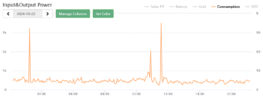And old fridges and freezers consume far more electricity than people realise
I was surprised how much more the upright uses to my chest freezer, this is why the picture shows so much for August, the monitor was on the upright freezer back then.
My background use is 300 to 500 watt, and my chest freezer uses 63 watt, about 1/3 on and 2/3 off, the upright a bit more, so can account for around 150 watt average with freezers, so say 50 watt for lights, that is still around 150-200 watt I can't account for, this PC must use some, and all the equipment on standby, I know the old Sky box used around 18 watt on standby to power the LNB.
I am not really worried, battery SOC is over 60%, and it is 11 pm, a lot better than normal, likely because did not watch TV tonight.
I clearly don't want to throw money away, but there is a limit to saving electric, as to smart meter, my meter is in the old garage, now a flat, so reading it on a regular basis is not going to happen. And the "In home display" all day it flits from a few watts import or a few watts export, it does not help one iota to work out what uses what.
The solar software shows what I use

you can see each cup of coffee I have made for self and wife, but if you think I am going to stop drinking coffee to save on electric you're in cloud-cuckoo-land.


